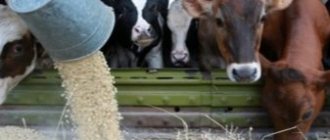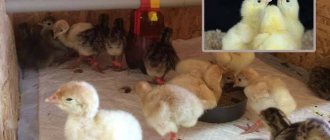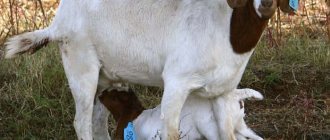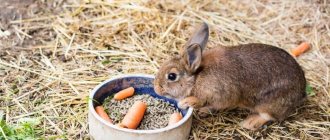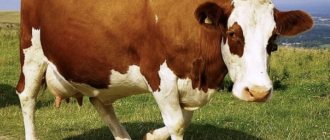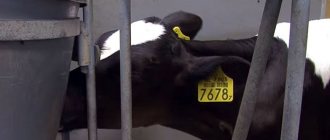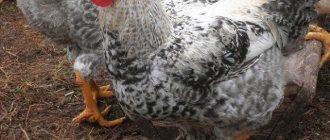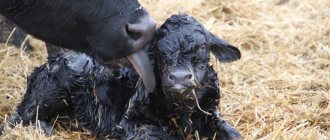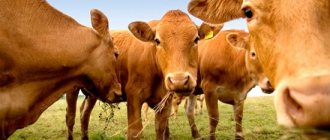How to determine the weight of cattle from measurements?
The live weight of farm animals, in particular cattle, is one of the most important indicators taken into account in breeding work.
Live weight of livestock is an important indicator for assessing meat and dairy productivity. Animals of the meat type are distinguished by a relatively early achievement of maximum weight, and animals of the dairy type are distinguished by a relatively long-term preservation of its optimal size. For better use of biological growth reserves, it is necessary to know the patterns of age-related changes in the animal’s weight and the norm of the genotype’s reaction to specific changes in living conditions.
Determining the live weight of animals by measurement is based on the fact that body weight is proportional to its volume. A special measuring tape or stick are the tools necessary for measuring, depending on the method of determining the live weight of the animal.
When determining the weight of cattle, the oblique length of the body is measured (from the extreme anterior point of the protrusion of the humerus to the posterior protrusion of the ischial tuberosity) and the girth of the chest behind the shoulder blades. Based on the obtained measurement values, the live weight of cows is determined using a special table (see table for measuring cattle weight by measurements).
Live weight is estimated for all groups of animals: young animals, cows, sires.
Determining the weight (live weight) of animals (livestock) by measurement (by measurements) gives an error within 20-30 kg in comparison with weighing on scales, and sometimes significantly less.
The accuracy of determining the live weight of livestock largely depends on the correctness of taking measurements. When looking at the animal from the side, the limbs should cover each other in an arch. The head should be in a horizontal position in relation to the body and not be pubescent or extremely raised upward.
Table for determining the live weight of cattle by measurements
| Chest circumference behind the shoulder blades (in cm) | Oblique length of the body (in cm) | ||||||||||||||
| 125 | 130 | 135 | 140 | 145 | 150 | 155 | 160 | 165 | 170 | 175 | 180 | 185 | 190 | 195 | |
| live weight of cows and bulls (in kg) | |||||||||||||||
| 125 | 164 | — | — | — | — | — | — | — | — | — | — | — | — | — | — |
| 130 | 180 | 187 | — | — | — | — | — | — | — | — | — | — | — | — | — |
| 135 | 196 | 203 | 213 | — | — | — | — | — | — | — | — | — | — | — | — |
| 140 | 216 | 223 | 231 | 241 | — | — | — | — | — | — | — | — | — | — | — |
| 145 | 232 | 240 | 250 | 259 | 268 | — | — | — | — | — | — | — | — | — | — |
| 150 | 247 | 256 | 266 | 277 | 286 | 296 | — | — | — | — | — | — | — | — | — |
| 155 | 264 | 274 | 285 | 295 | 306 | 317 | 328 | — | — | — | — | — | — | — | — |
| 160 | 282 | 290 | 301 | 313 | 324 | 334 | 347 | 356 | — | — | — | — | — | — | — |
| 165 | — | 310 | 323 | 334 | 347 | 358 | 370 | 381 | 394 | — | — | — | — | — | — |
| 170 | — | — | 342 | 355 | 368 | 380 | 393 | 404 | 417 | 431 | — | — | — | — | — |
| 175 | — | — | — | 374 | 390 | 403 | 417 | 429 | 443 | 457 | 470 | — | — | — | — |
| 180 | — | — | — | — | 414 | 428 | 443 | 452 | 471 | 486 | 500 | 515 | — | — | — |
| 185 | — | — | — | — | — | 449 | 464 | 478 | 494 | 508 | 524 | 540 | 552 | — | — |
| 190 | — | — | — | — | — | — | 492 | 506 | 522 | 538 | 555 | 572 | 585 | 602 | — |
| 195 | — | — | — | — | — | — | — | 531 | 549 | 566 | 582 | 600 | 615 | 633 | 648 |
| 200 | — | — | — | — | — | — | — | — | 580 | 597 | 614 | 634 | 649 | 667 | 684 |
| 205 | — | — | — | — | — | — | — | — | — | 626 | 644 | 662 | 680 | 699 | 717 |
| 210 | — | — | — | — | — | — | — | — | — | — | 678 | 699 | 716 | 736 | 754 |
| 215 | — | — | — | — | — | — | — | — | — | — | — | 734 | 751 | 773 | 792 |
| 220 | — | — | — | — | — | — | — | — | — | — | — | — | 782 | 804 | 825 |
| 225 | — | — | — | — | — | — | — | — | — | — | — | — | — | 843 | 863 |
| 230 | — | — | — | — | — | — | — | — | — | — | — | — | — | — | 905 |
Table for determining the approximate live weight of a calf
| chest circumference behind the shoulder blades, (in cm) | oblique length of the body, (in cm) | ||||||||||||||||||
| 90 | 92 | 94 | 96 | 98 | 100 | 102 | 104 | 106 | 108 | 110 | 112 | 114 | 116 | 118 | 120 | 122 | 124 | 126 | |
| 84 | 54 | ||||||||||||||||||
| 86 | 57 | 58 | |||||||||||||||||
| 88 | 59 | 60 | 61 | ||||||||||||||||
| 90 | 63 | 64 | 65 | 67 | |||||||||||||||
| 92 | 67 | 68 | 69 | 70 | 72 | ||||||||||||||
| 94 | 70 | 71 | 73 | 74 | 75 | 76 | |||||||||||||
| 96 | 73 | 75 | 76 | 77 | 78 | 79 | 81 | ||||||||||||
| 98 | 77 | 78 | 80 | 81 | 82 | 83 | 84 | 86 | |||||||||||
| 100 | 80 | 82 | 84 | 85 | 86 | 87 | 88 | 90 | 91 | ||||||||||
| 102 | 84 | 85 | 86 | 88 | 89 | 91 | 92 | 93 | 95 | 96 | |||||||||
| 104 | 88 | 90 | 91 | 92 | 94 | 95 | 97 | 98 | 99 | 101 | 102 | ||||||||
| 106 | 93 | 95 | 96 | 98 | 99 | 100 | 102 | 103 | 104 | 106 | 107 | 109 | |||||||
| 108 | 99 | 100 | 102 | 103 | 105 | 106 | 107 | 109 | 110 | 112 | 113 | 114 | 116 | ||||||
| 110 | 105 | 106 | 107 | 108 | 110 | 112 | 114 | 116 | 117 | 119 | 120 | 121 | 123 | ||||||
| 112 | 110 | 11 | 112 | 114 | 115 | 117 | 118 | 119 | 121 | 122 | 124 | 126 | 128 | 130 | |||||
| 114 | 115 | 117 | 118 | 119 | 121 | 122 | 124 | 125 | 126 | 128 | 129 | 131 | 132 | 133 | 135 | 136 | |||
| 116 | 121 | 122 | 124 | 125 | 126 | 128 | 129 | 131 | 132 | 133 | 135 | 136 | 138 | 139 | 140 | 142 | 143 | ||
| 118 | 123 | 124 | 126 | 127 | 129 | 131 | 132 | 134 | 135 | 137 | 139 | 140 | 142 | 143 | 145 | 147 | 148 | 150 | |
| 120 | 129 | 130 | 132 | 133 | 135 | 137 | 138 | 140 | 141 | 143 | 145 | 146 | 148 | 149 | 151 | 153 | 154 | 156 | 157 |
| 122 | 135 | 136 | 138 | 139 | 141 | 142 | 143 | 145 | 146 | 148 | 150 | 151 | 153 | 155 | 157 | 159 | 160 | 162 | |
| 124 | 142 | 144 | 145 | 147 | 148 | 150 | 152 | 153 | 155 | 156 | 158 | 160 | 161 | 163 | 164 | 166 | 168 | ||
| 126 | 150 | 152 | 153 | 155 | 156 | 158 | 161 | 163 | 164 | 166 | 168 | 169 | 171 | 172 | 173 | 174 | |||
| 128 | 158 | 160 | 161 | 163 | 164 | 166 | 168 | 169 | 171 | 172 | 174 | 176 | 177 | 179 | 180 | ||||
| 130 | 166 | 168 | 169 | 170 | 172 | 174 | 176 | 177 | 179 | 180 | 182 | 184 | 185 | 187 | |||||
table for determining the approximate weight of calves
In the absence of a special device, a table for determining the weight of cattle will prove to be an indispensable assistant. Weighing adults or calves is often difficult, but it is impossible to do without knowing the weight of the animals. This data is necessary when selling cattle, for studying development and during fattening. Enterprising livestock breeders have learned to do without scales and find out the weight using special formulas, using a tape measure or tape as a measuring tool.
Feeding scheme
The weight of calves by month corresponds to the norms if the feed contains all the necessary nutrients. In order for animals to grow faster, the farmer needs to know the feeding habits.
First month
At the first stage of animal development, the owner’s main task is to strengthen the calf’s immunity. Only dairy products are used for this. Within an hour after birth, he should receive valuable colostrum. It is distinguished from milk by its high protein content, which helps strengthen the body of babies.
Mother's colostrum is the main diet for the calf immediately after calving.
A newborn bull is fed 5-6 times a day. They do this using bottles with nipples. The hole in them must correspond to the age of the animals in order for the sucking reflex to develop correctly. Each individual is provided with a separate nipple. After use it is disinfected. By the age of one month, the number of feedings is reduced to 3-4 times.
Fresh milk is given, but frozen milk is also suitable. Its temperature should be 37-38 °C. Milk from different cows is often mixed. This provides the calf with antibodies that will help build immunity. To ensure that the bull gains weight well and does not carry weight, vitamins are also added to the food - biovit or others.
Second month
Gradually switch to solid food. They start with starter feed. It consists of products containing elements necessary for a growing organism. Such food is easily digestible because it contains the following products:
After the first week of feeding with compound feed, ruminal digestion is established, so hay is introduced into the diet. Every day, portions are increased by 150-200 g. Silage and haylage are added to the main feed.
After 60 days, the calves are given root vegetables and yogurt. Oatmeal jelly will provide them with vitamins A, D, E. Feeding is done often, in small portions. The approximate amount of feed per day is 1.5-1.6 kg, including 1 kg of hay.
Third month
The bull's body is completely ready for the transition to solid food. It is worth providing it with plenty of protein. Milk is gradually being replaced with products that have high energy value. Soy-based concentrates are good for this. It is given in a dose of 2% as part of compound feed, which also contains the following:
- peas – 30%;
- barley – 23%;
- corn – 20%;
- minerals and premix – 5%.
For optimal development, the calf needs a sufficient amount of succulent hay, so from the end of 3 months the baby is taught to independently graze on pastures
You can prepare the food yourself, you just need to calculate the proportions correctly. This composition contributes to the rapid weight gain of bulls. At this age they are not selective in food, weigh about 100 kg, eat a lot and always leave their feeders empty. They are also given bran, fruits, and vegetables.
From 4 months to six months
During this period, for good weight gain, it is worth giving animals 1-2 kg of feed per day. In the warm season, they are grazed for 2-3 hours. It is important that there is water and a shaded place nearby. In cold weather, calves also need to be walked. They are briefly released into the pen, which has a canopy. When grass is introduced into food, it is first dried. Then they gradually switch to fresh ones. This will help prevent stomach upset. By six months, milk is completely removed from the diet.
From 6 months to a year
For a bull, this is a period of intensive growth and muscle mass building. The musculoskeletal system is actively developing. Feeding is carried out 3 times a day. The diet should contain mixed feed, hay, and concentrates.
From 8 to 12 months the feeding principle remains the same. In order for a bull to gain weight, it is worth increasing the amount of vitamins and nutrients. As the animal grows, the need for them also increases. If you do not provide it with the necessary elements, this will have a bad effect on the body of the bull, which will entail the following consequences:
- inactivity of the animal;
- stopping weight gain;
- weight loss;
- deterioration of immunity.
Sources:
https://fermers.ru/zhivotnovodstvo/krs/ves-telenka https://fermer.blog/bok/zhivotnye/krupnyy-rogatyy-skot-krs/anatomiya-korovy/158-skolko-vesit-korova.html https: //pro100ogorod.ru/korovy-i-byki/ves-telenka-po-mesyacam.html
How to find out the meat yield
The indicator is measured as a percentage.
It amounts to:
- 40–50% for dairy representatives;
- 80% for meat;
- 70% for meat and dairy.
Important! To calculate the meat yield, the mass is calculated using scales, since all other methods give only approximate figures and are intended to create a complete diet. Slaughter yield increases with age
The amount of meat products is influenced by diet and climatic conditions. It is also important to take into account the purpose of the breed. The average weight of different parts of a meat and dairy cow with a slaughter weight of 700 kg, subject to a meat yield of 60% (420 kg):
Slaughter yield increases with age. The amount of meat products is influenced by diet and climatic conditions
It is also important to take into account the purpose of the breed. The average weight of different parts of a meat and dairy cow with a slaughter weight of 700 kg, subject to a meat yield of 60% (420 kg):
- head – 10 kg;
- liver – 5 kg;
- tongue – 2 kg;
- heart – 3 kg;
- kidneys – 2 kg;
- front leg to hock joints – 2 kg;
- hind leg – 3 kg;
- skin – 17 kg;
- stomach – 15 kg;
- tail – 2 kg;
- fat – 5 kg;
- bones – 112 kg.
Not every private household has scales. When maintaining, for example, one unit, there is no need to buy them. You can, of course, agree and use those installed on the nearest farm. But if you follow a weighing schedule, you will have to do it too often. Therefore, it is better to use alternative methods for converting linear indicators into weight ones.
According to Trukhanovsky
In this case, use the formula. It is applicable when determining the weight of an adult bull. To calculate, you need to specify two parameters.
- Chest circumference. The measuring location is very close to the bull's front legs. You can measure with a special tape measure or a centimeter.
- Straight body length. That is, find out the distance from the beginning of the neck to the beginning of the tail (see Figure 1). An ordinary stick is suitable for measuring. Make marks on it in the right places, and then measure the distance between them.
Trukhanovsky's formula
- M - measured mass in kg,
- K is the correction factor. Its value is determined by the breed of the animal being measured:
- for meat - K = 2.5,
- for dairy - K = 2,
- A - measured chest circumference (cm),
- B - measured straight length (cm).
To obtain a more accurate value, it is necessary to take into account the fat content of the bull.
- If it is high, add 5 or 10% to the resulting weight.
- If it is low, 5% or 10% is subtracted from the resulting weight.
We suggest you read: How to treat udder swelling in a cow
It is also suitable for determining the weight of an adult bull. Using this method, two measurements are taken in the same way. The first one is the same. But the second one is different. It's called oblique length. How it is measured is shown in Figure 2.
Correct measurements on animals for the Klüver-Strauch method
Table for determining the mass of cattle
Regression equations
With this method, one parameter is used - chest circumference. And then the following formulas are used.
Y1 = 5.3 * X – 507 - applied at X = 170 ÷ 180 (cm).
Y2 = 5.3 * X – 486 - applied at X = 181 ÷ 191 (cm).
Y3 = 5.3 * X – 465 - used for X ≥ 192 (cm);
X - chest circumference (cm).
We examined three universal methods for converting linear measurements of adult cattle into their weight indicators. These methods are suitable for any breed.
- Chest circumference, measured as usual - as close to the front legs as possible.
- Abdominal circumference measured at its widest point.
Measuring the circumference through the widest part of the abdomen. The data obtained is compared with a special table (they can be found on the Internet).
Tape for measuring live weight of cattle of certain breeds
To use it, you must first purchase it, and this is not always easy to do. Then you can take an ordinary centimeter, take the necessary measurements on the animal, and then work with the table. But tape is, of course, more convenient.
With its help, one measurement is taken - chest circumference (closer to the front legs). When taking measurements, there is no need to spare the tape. It is pulled tightly so that the existing hairs are crushed. In this case, the animal should stand calmly, with its head not lowered. As a result, the desired weight of the animal will be immediately written on the tape above the obtained measurement value. Very fast.
Unfortunately, all the proposed methods are not ideally accurate. The error may be 20-30 kg. To get an accurate result, you still need scales.
Turkhanovsky method
A special formula is used here that can be used to identify weight in adult bulls. The following indicators are used for calculations:
- sternum circumference. The measurement is made in the immediate vicinity of the animal's forelimbs. For this, a special tape measure or centimeter is used;
- straight body length. Measure the distance from the beginning of the cervical region to the tail. You can measure with a wooden stick with marked marks.
The mass is calculated using the formula below:
M=(A*B)/100*K, where
- M – weight in kilograms;
- K – correction factor. The value is determined by the breed of the animal being measured;
- A – sternum circumference (in cm);
- B – straight length of the body (in cm);
The coefficient for the meat direction is 2.5;
For the dairy direction – 2.
To get more accurate values, it is recommended to take into account the fat content of the bull.
Measuring tape
If it is high, then you need to add from 5 to 10% to the resulting value, and if it is low, then subtract the same percentage.
Livestock weight according to measurements, weight table
In the absence of measuring instruments, pre-made measurements and a special table for determining the weight of cattle allow you to find out the weight of a cow. It gives an idea of the approximate weight of the animal with an error of 20-30 kg. To check, you need to take the following measurements using a tailor's tape or tape measure:
- Body circumference in the sternum area. To measure, the tape is passed behind the animal's shoulder blades and connected in the chest area.
- Oblique length of the body. The tape is pulled from the cow's shoulder to the ischial tuberosity (a special protrusion on it).
Cattle weight measurement
The data obtained during the measurement is entered into a special table. Such tables were developed by experienced livestock breeders and exist in several versions.
Using the regression equation
If you have a measurement of the animal's chest circumference, you can determine the weight on the spot and without using a table. In this case, a special regression equation is used, which has the following form:
In this formula, “Y” means the weight of the cow, “x” is the exact value of the animal’s chest circumference, “X” is a special coefficient that assumes one of three values:
- with a chest circumference of 170–180 cm – 507;
- with an indicator of 181–191 cm – 486;
- if the girth is 192 or more - 465.
Reference. To determine mass, all values are substituted into the formula. The resulting value indicates the approximate weight of the animal and also approximately corresponds to the numbers indicated in the table.
Freuven method
The Freuven method is designed to determine the weight of young animals based on measurements taken. In this case, the chest girth and oblique length of the calf’s body are also measured, but the figures obtained during the measurement are substituted into the table presented below:
Determination of the weight of young animals using the Freuven method
The rules for using the table here are quite simple and actually repeat other table options that are available on the Internet. But the numbers given in the list have been adjusted taking into account the characteristics of the body proportions and growth of the young animals. The weight value is located in the cell located at the intersection of the desired column and row.
Klüver-Strauch method
Another popular measurement method is the Klüver-Strauch method. A table is also used here, but the values presented in it apply only to adult cattle. The Klüver-Strauch list assumes the following form:
Determination of cattle weight by the Klüver-Strauch method
The table is used in the same way as Freuven's version. In accordance with the values of the girth and oblique length of the body of the cow, the corresponding intersection point is selected. It will indicate the mass of living creatures.
Important! This method allows you to monitor the growth rate of the cow and its compliance with recommended standards. In addition, many breeders use it to control the weight of heifers during pregnancy.
Trukhanovsky's technique
You can also obtain the approximate weight of a calf using the Trukhanovsky method. It involves using a mathematical formula:
In it, “Y”, as in the regression equation, means the mass of the animal. The number “A” indicates the circumference of the baby’s chest, “B” is the oblique length of the calf’s body, indicated in centimeters. The letter “K” denotes a special coefficient, which is influenced by the breed of the animal. If the calf belongs to the meat breed, then K = 2.5. In the case when the breed is dairy, K=2.
In addition to all the numbers, for a more accurate result you should also pay attention to fatness. If the calf is overly fat, another 5–10% is added to the result.
If the baby is thin, then his weight, on the contrary, is reduced by the indicated proportion.
Using a special tape
For those breeders who are too lazy to carry out calculations and check with the table, there is an option for measuring the weight of cattle using a special tape. Instead of units of length, units of weight are immediately marked on it. In this case, the measurement is carried out strictly behind the front legs of the cow.
It is worth noting that this method involves the greatest error. Therefore, several rules should be followed when measuring:
- The tape is wrapped as tightly as possible, making sure that it lies strictly perpendicular to the cow’s body and slightly squeezes her sides.
- The measurements are repeated at least three times. The results obtained are summed up and the average value is sought.
- The weight value is compared with the fatness of the cow, after which 5–10% of the result is added or reduced.
Factors affecting weight
The weight of cattle is related to housing conditions and care, as well as feeding ration. The breed of the animal also plays a significant role. Dairy cows need to be on pasture for a long time, and meat cows are recommended to be kept in a stall or pen.
If they are kept on pasture for a long time and driven over a certain distance, they will lose weight.
Conditions of detention
When constructing or reconstructing another building for a cow barn, a number of requirements must be taken into account:
- Providing livestock with a temperature regime of at least +10°. For young animals not lower than +15°.
- Air humidity in the barn and lighting, air ventilation. If ventilation is provided by window openings, they must be made to open.
- No drafts and a calm environment.
- Animal bedding. This could be straw, sawdust, peat.
- The presence of pasture near the barn will have a positive effect on the milk yield of cows, since fresh air, sunlight, and movement are necessary for animals, especially dairy and meat - dairy breeds.
- If there is a lake or other body of water in the grazing area, it must be fenced off from the herd, as this can cause the livestock to become infected with parasitic diseases. Animals must be given water in a specially organized place with clean water.
- In winter, cattle should be allowed out into the paddock for a walk. Place a stack of hay in the middle and the cows will feed on roughage. Systematic walking of livestock has a positive effect on blood circulation, digestion, and prevents leg disease.
- Manure must be removed daily, as its accumulation and formation of gases cause respiratory complications and lead to hoof pathology.
- When keeping cattle on deep litter, manure is removed once in the spring, and during autumn and winter it is constantly necessary to put it in the stall. With this method, labor costs are reduced, the temperature in the barn increases, but bedding must be prepared twice as much and ventilation must work well.
Feeding the animals
The feeding diet of cattle must be balanced.
It should include:
- Rough and succulent feed of plant origin. Rough feed includes hay and straw. Juicy feeds include silage, haylage, fodder beets, and potatoes.
- Concentrates, which include grain, cake, bran and others.
- Bone meal, compound feed.
- Vitamins and mineral supplements, as well as waste from the chemical and food industries.
We must adhere to the feeding regime. Livestock must be fed 3 times a day. Grain and succulent feed should be given in the morning and at lunchtime, and roughage is better in the evening. If there are no automatic drinkers in the barn, you need to monitor the presence of water in the drinking tank.
Water for drinking must be clean, free of impurities and odor. When raising bull calves for fattening, their diet differs from feeding cows.
During the day, a bull eats up to 100 kg of feed in 3 times. Duration of fattening up to 20 months. In recent months, it is necessary to limit the animal’s mobility and put it on a leash. At this time, bulls become aggressive fighters.
When feeding one bull per year, he eats about 3 quintals of hay, the same amount of feed, as well as a lot of silage straw and vegetables.
During the first year of life, with proper fattening, the weight of a 1-year-old bull should increase 8 times compared to its birth weight. This is an indicator of proper feeding of the animal.
Determining the weight of a bull
In order to control the rearing of bull calves, their weight must be measured regularly. This will not only help you evaluate the expected profit, but will also make it possible to adjust your work with them.
Not every household has the right type of scales. In addition, if a small number of cattle are raised, then it does not always make sense to purchase them.
After all, if the rate of weight gain deviates from normal, this usually means that it is necessary to understand what reasons could influence this. In some cases, for example, you may need to make changes to your diet.
Important! It is usually customary to use scales for weighing, but in practice methods have been developed where there is no need to use them to estimate the weight of an animal. It was found that the weight of a bull is related to its size
In most cases, you need to measure two quantities with a cattle measuring tape:
- The length of the segment that starts from the anterior chest protrusion in the lower part of the body and ends at the highest point of the seat (where the tail begins).
- Another required value is the circumference of the torso, which is measured vertically, in the upper part it passes behind the shoulder blades, and in the lower part, just behind the front legs.
The first measurement is usually called the oblique length of the torso.
Cattle measurement table
A table is shown on how to find out the weight of a bull without scales. It indicates how to determine the weight itself by measuring the oblique length of the torso and the circular girth.
The cattle weight table is applied as follows. Depending on the oblique length of the body, a column is selected, the row is determined by the size of the girth.
Let's give an example of calculating live weight using the cattle table. Suppose the length is 165 cm and the girth is 195 cm. Having found the column and row in the indicated way, you can determine from the corresponding cell that the weight is 549 kilograms.
To determine the weight of a calf, another table is used. It is used in the same way as the previous one: based on the oblique length and the size of the chest girth, the necessary column and row are found where the weight is indicated.
Table for determining the live weight of a calf
Using these tables, you can control the weight of cattle without carrying out a weighing procedure.
How much does a calf weigh at different stages of its life?
It is very difficult to answer this question unequivocally, because everything depends on the breed characteristics and individual characteristics that affect the weight of the newborn.
As a rule, calves are born with an average weight of 30 to 40 kg. As soon as the birth process is completed, you should not immediately take it away from the cow, you should give her the opportunity to lick the baby. This process results in the cow receiving amniotic fluid, which accelerates the process of separation of the placenta.
In the first 30 days from the moment of birth, it is common for young animals to gain up to 0.8 kg per day. Due to the structure of the stomach, in the first week during artificial fattening, the calf is not given more than 1.5 liters per feeding. If you do not comply with this norm, then excess dairy products will end up in the intestines and, most likely, will cause digestive system disorders. To avoid such trouble, young animals are fed in small portions up to 5 times a day.
By day 60, the calf gains weight up to 80 kg. From this moment, complementary feeding with hay and mixed feed begins in small quantities so that the baby gets used to the food of adult animals. At the same moment, the volume of dairy products during feedings decreases. It is recommended to carry out the calculation in such a way that by the age of six months the animal switches to a regular diet.
By the age of six months, calves weigh 120–180 kg, again, this depends on the breed characteristics. You can start taking the young animals out to pasture so that they get used to green food. It contains all the necessary components that will help the young body grow and develop properly.
The average weight depends on the life period of the young. By the age of 365 days, some weigh about 400 kg; by two years, this figure doubles with an average of 600–700 kg. Much depends on gender; as a rule, bulls are somewhat more powerful than heifers. At the age of three, a former calf can reach a weight of 1200 kg or more.
In order for calves to gain weight well, they must be provided with high-quality feed.
Calculating the weight of bulls
The gender difference between cows and bulls is significantly manifested in body weight - bulls are much larger. As they grow older, the difference in weight becomes greater - if newborn heifers are 20% lighter, then in adult animals this difference is 40, or even 50%. There are no special ways to determine the weight of a bull without scales. The Trukhanovsky and Kluver methods are applied to them, as well as to cows.
meat bull
As for calculating the meat yield, it is important to know that this is a breed value, which also depends on the type of productivity of the animal:
- The slaughter weight of dairy cattle rarely exceeds 50% of live weight. More often the numbers are in the range of 40-45%, and the bones are more than 20%;
- the slaughter weight of meat representatives is more than 55%. The record holder in this sense is the Aberdeen Angus breed - in it this figure ranges from 65 to 75%.
At the same time, dairy cows have not only little muscle mass, but also fat, while representatives of the opposite direction have more meat, it is nutritious and high-calorie.
All cattle bred for agricultural purposes are divided into beef and dairy, as well as mixed (meat and dairy), while:
- Meat animals quickly gain weight - the average weight gain per day is 1 kg. Thanks to this, representatives of some breeds already weigh more than half a ton by 15 months. The body weight of a newborn calf is, on average, about 40 kg. Belgian Blue beef bull
- Breast milk gains slowly and evenly. The weight of a newly born dairy calf is 20 kg, which is less than that of representatives of the meat category. The average daily gain is about 600 g, in mixed breeds it is 100 g more. Such calves acquire muscles and grow longer than their meat counterparts. But if we talk about adult animals that are 5 or more years old, the difference is not too great. Thus, dairy Holstein cows weigh more than 700 kg, and their bulls weigh more than 1300. Such indicators can be called decent for meat animals. At the same time, within the breed the difference in live weight is noticeable.
In addition to the usual weighing, there are several options to help determine how much a bull weighs. All methods are based on the ratio of body weight and volume of the animal. Techniques that do not involve the use of scales include:
- according to the Trukhanovsky formula;
- according to the Kluwer-Strauch table (Freuven for calves);
- around the circumference of the abdomen and chest;
- using a measuring tape.
Many farms use simple calculations rather than measuring instruments to determine a bull's weight. This is due to the fact that a bull calf at 2-3 months can still fit on a scale, but for adult animals such scales will not be easy to find. And driving an animal onto a weighing platform is not the easiest task.
It is for this reason that calculation models were invented: the Trukhanovsky method, the Clever-Strauch table, the Freuven table. For some breeds, there are separate calculation formulas, since they are much larger than the standard dimensions that cattle reach. For example, the black and white breed.
This table and formula will help you find out how much cows and bulls weigh in adulthood. There are other methods that do not require mathematical calculations to calculate the weight of a newborn calf.
Bull's weight depending on breed
To know the exact data on how much a bull weighs in live weight at 1 year, one takes into account not only the average growth rates, but also the characteristics of the breed. Cattle are available for dairy, meat and meat and dairy production.
Beef cattle
Beef cattle are characterized by rapid weight gain compared to representatives of other breeds. Animals have developed muscles.
Example of popular meat breeds:
- Galloway. Males are usually kept from 1 to 1.5 years. During this period they gain up to 550 kg. The weight of an adult bull is 0.900 tons, a cow - 0.65 tons.
- Hereford. A one-year-old bull gains up to 500 kg of live weight. An adult male weighs 0.8 tons, a cow - 0.6 tons.
- Ukrainian. A one-year-old bull can gain from 600 to 700 kg. The weight of an adult male is 1.3 tons kg, a female cow is 0.8 tons.
Hereford bull
The meat category includes Aberdeen, Charolais and other breeds, from which high-quality meat is obtained.
Weight gain and average daily gain of calves
An indicator such as the weight of a bull is the basis of many farming tasks. Using it, you can determine which weight class the bull belongs to, calculate the average daily gain and track the level of development. That is why, in the first months of life, cattle breeders regularly measure the weight of the bull, monitoring the obtained indicators.
The calf actively develops during the first six months of life. During this period, farmers constantly take measurements and monitor weight gain. Strict control is important not only for those calves that are fattened for meat, but also for replacement heifers.
The table below will help you determine the norms of weight and average daily weight gain at the main stages of development of young animals.
The table shows that at 3 months, calves reach an average daily gain of 700 g and maintain it for up to six months. Moreover, during this period of development, the weight of the calf is not at all affected by the class of the calf. The only difference is that a breeding heifer is born with more weight than replacement breeds.
Approximate calf weight by month from birth to 1 year
You need to know the weight throughout the entire period of keeping the animal and be able to measure it. Bulls are usually kept for up to 1 year, after which they are sold or slaughtered. If left for breeding or raised for up to 2 years for more meat, the animal grows up to or more than 1 ton, which depends on the breed.
A normal calf immediately after birth weighs on average 40 kg, which is considered to be 10 parts of the weight of a cow. A young healthy bull with the correct feeding diet rapidly gains weight. After a year, its mass increases 10 times, which is 400 kg.
If we consider the gain by month, it looks like this:
- newborn – 40 kg;
- two months – 60-80 kg;
- three months - 100 kg;
- six months - 170 kg.
At one year of age, the weight of a bull reaches 400 kg, but these are average figures. The final result depends on the breed of cattle.
There are 4 categories of cattle:
- Top grade. The weight of the animal reaches 500 kg, and some specimens grow much heavier.
- First grade. The average weight of bull calves varies from 400 to 450 kg;
- Second grade. Bulls in this category weigh from 350 to 400 kg.
- Third grade. Representatives of the smallest category of cattle weigh from 300 to 350 kg.
When the weight of a one-year-old male is less than 300 kg, this indicates his illness or improper feeding.
Fattening bulls
It is recommended to weigh cattle twice a month, which helps to monitor the development of animals in more detail. When the male reaches full maturity, his weight should be 1.5 times the weight of the cow (1.2-1.5 tons).
Methods for measuring the weight of an adult cow
You don’t have scales, but you need to find out the dimensions of the animal, then the following methods will help you determine the mass. All you need is a measuring tape, a few formulas and tables. You will find them right here. Of course, all these methods allow you to determine approximate data, that is, whole numbers without taking into account grams. But even this will be enough for you in personal practice. For example, such knowledge will help to correctly formulate an animal’s diet.
By chest and abdominal circumference
After calculating and analyzing a large amount of biometric data, scientists were able to create a special table for determining the live weight of cows by abdominal volume. Initially, this method was provided only for the black-and-white breed. To determine it, you need to measure the girth of the chest and abdomen in the largest part of it. Check the data against the table.
By regression level
To determine weight using this method, you need to measure the circumference of the chest: take a measuring tape and circle it around the animal’s body so that it lies under the chest. Next, we calculate the data using the equation. In this case, the first formula is applied if the chest circumference is about 170-180 centimeters, the second - at 181-191 centimeters, the third - more than 192 centimeters.
Y – live weight of the cow in kilograms;
X – chest circumference behind the shoulder blades in centimeters.
Dairy cattle
Dairy cattle are raised for milk. The quality of the meat goes by the wayside. Dairy bulls gain less weight compared to representatives of the meat and meat and dairy breeds.
Average weight of adult animals:
- Holstein. The breed is considered large in the dairy direction. A bull grows weighing up to 1.2 tons, a cow - up to 0.65 tons.
- Red steppe. The widespread breed has good growth rates. Bulls grow to weigh 0.85 tons, the average weight of a cow is 0.4 tons, but there are large individuals - up to 0.5 tons.
- Black-and-white. The breed is also considered widespread; its representatives are characterized by good growth. The weight of an adult bull reaches 0.8 tons, a cow - 0.5 tons.
- Kholmogorskaya. Among the dairy breed, the breed is quite small. Adult bulls grow up to 0.75 tons, cows - about 0.6 tons.
Young dairy bulls are reluctantly taken for meat because of their low fatness, and their quality itself is inferior to representatives of meat breeds.
The importance of feeding a newborn calf
The task of every farmer after the cows calve is to feed the calves with colostrum. This product is an essential source of vitamins and minerals that create a strong and healthy immune system from the first hours of an animal’s life. Its distinctive feature from ordinary milk is its higher protein content, which is the basis for the formation of a strong body.
It is important to feed newborn bulls with colostrum in the first hour after calving. Every farmer should do this exactly in the first 60 minutes after birth. Any delay in feeding increases the likelihood of bull mortality and poor performance in the future. Such animals grow poorly and are difficult to gain weight.
Prerequisites for calculating body mass index
There are several prerequisites that allow us to give a detailed answer to the question of why to determine the indicator in question. The first is to assess the health of the offspring (which is why there are separate calf weight tables). The second is the possibility of making a decent profit (the larger the animal’s weight, the higher the seller’s income). The third is an assessment of the productivity of cattle (tables for determining the weight of calves help to identify the fertile younger generation). The fourth is to learn how to create the right diet to maintain good health and increase the life expectancy of livestock.
For example, the girth weight of a bull indicates its ability to procreate, therefore, such a specimen should not be slaughtered, although the demand for such an individual will be high, as will the price.
The average body weight of a cow allows cattle to be divided into the following groups: selective (around half a ton), first class (about 430 kg), second class (390 kg), third class (slightly more than 300 kg)
It is important to know that the value under consideration depends not only on nutritional characteristics, but also on the breed of livestock. For example, a porcelain white male can be 750-800 kg
A properly studied and used cow weight chart can make a farmer a rich man. Do not agree? Get acquainted with the features of setting the final body weight of an animal to change your mind.
Feeding for the first six months
Feeding bulls is different from feeding heifers. They begin to prepare for adult food from the age of 2 months. In addition to milk, they are given hay, combined feed, and vegetables. The goal of fattening is to accelerate the gain of muscle mass so that in a short time small calves grow into large bulls. How should they be fed?
Read also: New Year's festive table recipes
In the 2nd month, the bulls continue to be given whole milk, but the portion is divided into parts: 4 liters of whole milk and 4 liters of skim milk. The diet begins to be balanced with hay. Rough feed is given up to 400 g. This is necessary for the full formation of the scar part of the stomach.
The grain mixture will replenish the body with proteins. Young animals need 200 g. Protein will help build muscle mass. Mineral supplements will strengthen the skeletal system. Among them are table salt and phosphates. By the end of 2 months, the calf already weighs 84 kg. He drinks his portion of whole milk and skimmed milk. The amount of roughage increases to 500 g. The grain mixture is given 700 g.
At the beginning of 3 months, root vegetables begin to be introduced into the diet. Experts recommend boiled warm potatoes. The first portion of potatoes is 200 g. By the end of the period, the amount of potatoes is increased to 500 g. The bull eats already one and a half kilograms of the combined feed. Whole milk is not given to the calf. It is replaced with the opposite. During the entire time, the amount of milk should not exceed 10 liters. By the end of 3 months, the weight of the bull is 110 kg.
At 4 months, the calf’s nutrition undergoes changes. They begin to add succulent food to his diet. Choose corn silage. The first portion is 500 g. By the end of the period, the bull eats 1 kg. The portion of skim milk is reduced to 8 liters. The amount of hay is increased to 1.5 kg by the end of the month. A calf eats 1.6 kg of grain mixture. Root vegetables are given raw. They are washed and finely chopped. Vegetables can include not only potatoes, but also sugar beets, carrots, and pumpkin. They make a vegetable mixture, but it is not recommended to give it more than 1 kg per day. By the end of the period, the weight of the bull grows to 136 kg.
Over the course of the 5th month, reduce the amount of skim milk from 8 liters to 4 liters. The calf eats 2 kg of hay by the end of the month. The amount of combined feed increases. By the end of the period, the calf can eat up to 1.8 kg. They continue to give vegetables. The share of silage in the diet increases to 2 kg. By the end of the month, the calf’s body weight reaches 163 kg. He is brought into the herd with other young animals.
At six months of age, bull calves weigh 190 kg. They no longer drink milk. They completely switch to the diet of an adult animal. The amount of succulent feed is increasing. By the end of the month, the bulls eat 6 kg of silage and 1 kg of root vegetables. Hay is needed 3 kg. The rate of concentrates is increased to 2 kg. Calves consume up to 20 g of salts and 25 g of phosphorus supplements.
Calves in the dairy period are given antibiotics to accelerate growth. They speed up metabolic processes in the body. The weight gain of young animals with the use of antibiotics increases by 12%. At six months, a bull can weigh an average of 219 kg.
For the first 15 days, calves are kept in a nursery. These are cages in which the floor is raised 50 cm from the ground. The floor is made of wooden slotted wood. It is covered with straw, which is changed daily. At this time, be sure to monitor your diet. Calves are not allowed near cows. Colostrum is milked and given in a bottle. This allows you to control the portion of milk consumption. From the nursery the calves are transferred to pens where the calves are kept for up to 5 months. At six months the young animals are united into a separate herd.
How to feed newborn calves
In order for the calf to grow and develop quickly, it is necessary to know about the peculiarities of its feeding. The main task is to create a strong immune system, which will create the necessary conditions for the baby to develop faster, because during the first month of life the animal needs this most, so from the first day the little bull needs to be fed 5-6 times a day. Special bottles with nipples are used for this. It is necessary to select the correct diameter of the hole in them so that desoldering does not cause:
- dullness of the sucking reflex;
- curdled formations in the abomasum;
- swallowing large portions of milk.
It is best to give calves fresh milk, although frozen milk can also be used. The main thing is that it has a temperature of 37-38°C. Many livestock breeders also use collected milk from different cows for feeding. The antibodies that such a product receives create immunity that is strong against infectious diseases. Such methods are also welcome if the mother of calves suffers from mastitis. If the farmer does not know the nuances of how to feed a bull so that it gains weight, there will be no gain, as well as profit from the calf.
